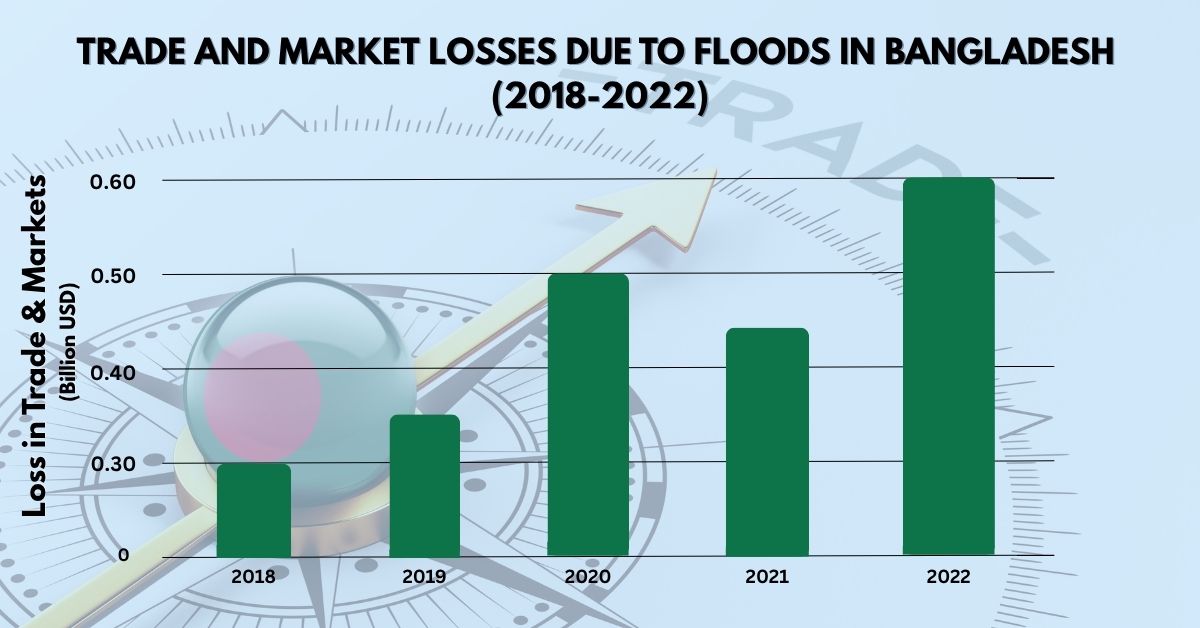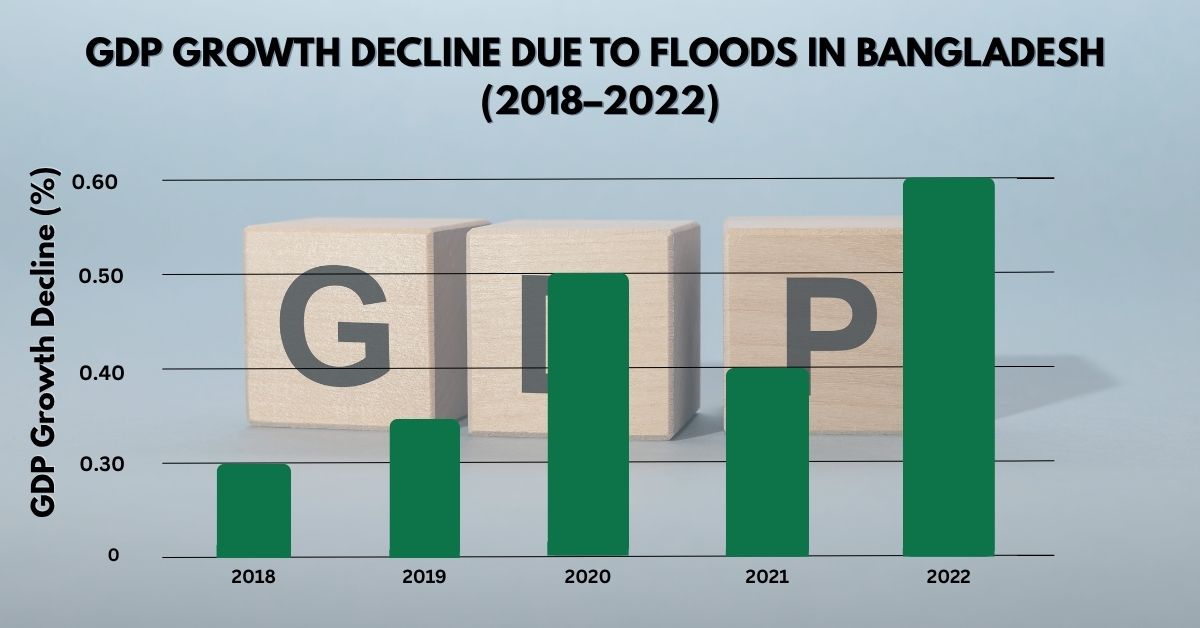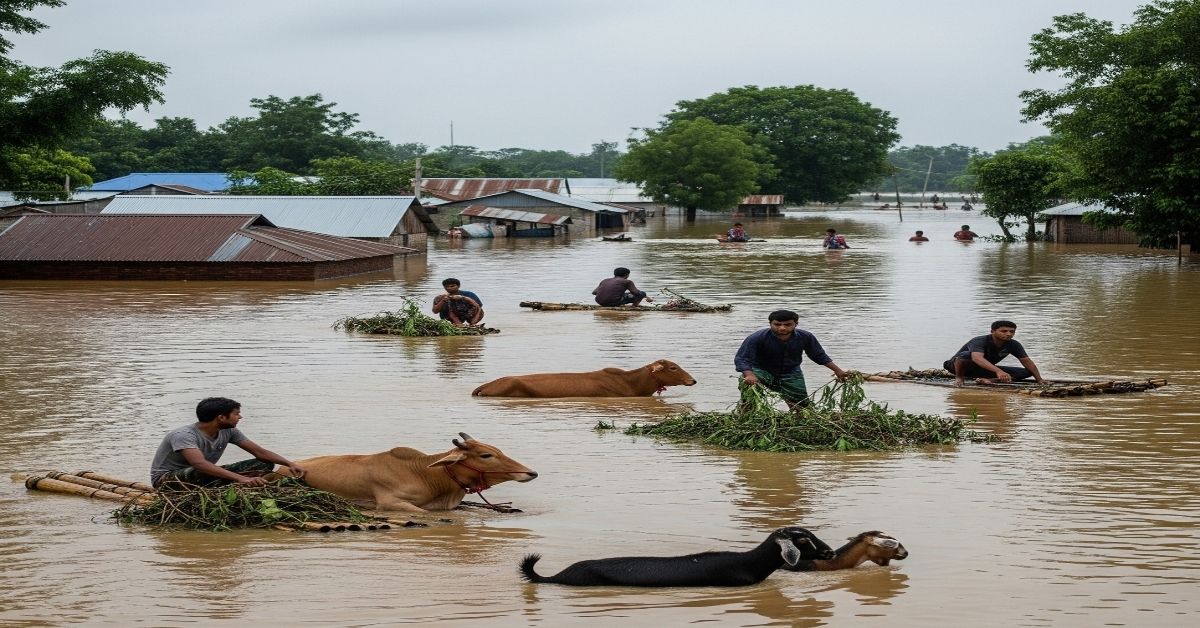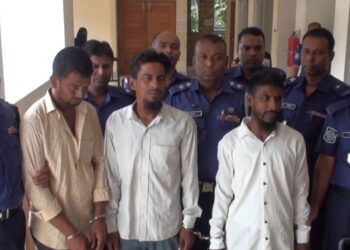Introduction
When the Rain Becomes a Threat and Living with the Fear of Flood Crisis in Bangladesh
Bangladesh is a South Asian country with a tropical monsoon climate and is located at the edge of the Bay of Bengal. It is a fertile land full of rivers, where nature is both beautiful and challenging. It’s are a well-known disaster in the lives of Bangladeshi people. Every year when the monsoon comes, thousands of people worry, what if water enters the house, what if the crops are drowned? Whether it’s a city or village, riverside or plain land floods seem to touch everyone.
Flood crisis in Bangladesh is not just about water and damage. It deeply affects our economy, society, and future development plans. Every year, around 20-25% of the land is affected by normal floods. But during major floods, it can go up to 60%. As a result, houses break down, schools and colleges close, children suffer from malnutrition, and the country’s economy faces problems. In Bangladesh, floods are not just a natural disaster they are a reality closely connected to people’s lives.
Historical Background of Flood in Bangladesh
As Bangladesh is a riverine country crossed by 700 rivers, not strong to control flood. That’s the main reason why Bangladesh flooded. For this flood,this nation faces seasonal flooding of many damages,like disrupts millions of lives, damages infrastructure and weakens the economic backbone of rural and urban areas.
Flood crisis is no longer a seasonal hardship, become a multi-dimensional threat for the nation. For this not only nature faces many challenges but also human life effected on their life and health.
Bangladesh faces many major floods in the 18th and 19th century and also in 20th. But this number is increasing day by day which is a big threat for nature and human life.
Six major floods in 18th century were recorded,those are in 1842,1858,1871,1875,1885 and 1892. On the other hand, in 19th century this country faces eight major floods, in 1951,1987,1988,1998. 20th century also faces some floods and those also major.
In 19th century
•1987 occured floods throughout July and August, effected 57,300 square kilometres (22,100 sq mi) of land, (about 40% of the total area of the country) and was estimated as a once in 30-70 year event.
•1988 occured floods throughout August and September.About 82,000 square kilometres (32,000 sq mi) of land, (about 60% of the area),its return period was estimated at 50–100 years and leaving around 45 million people homeless and causing billions in damages.This year the flood lasted 15 to 20 days.
•1998 occured floods throughout 75% of the total area of the country was flooded.30 million people were made homeless and the death toll reached over a thousand.The flooding caused contamination of crops and animals and unclean water resulted in cholera and typhoid outbreaks.700,000 hectares of crops were destroyed,400 factories were forced to close, and there was a 20% decrease in economic production. Communication within the country also became difficult.
•1999 flood was not as serious as 1998 floods. This flood occur between July and September. But this flood causing many deaths and leaving many people homeless. This flood lasted approximately 65 days.
In 20th century
- 2004 flood was similar to 1988 and 1998 floods. This year happened two types of flood, one is major and another is minor.
- 2005 occured flood throughout early October. In this flood dozens of villages were inundated when rain caused the rivers of northwestern Bangladesh to burst their banks.
- 2007 flood that hit Bangladesh and affected 252 villages in 40 districts causing millions of people became homeless.
- 2015 flood also occur but this year flood was not so much harmful.
- 2017,this year for early heavy rain cause flooding. For that several part of pre-harvested crops in April was damaged. Based on sentinel-1 image, in March 2017 perennial waterbodies covered 5.03% of Bangladesh. In April, a total flood-inundated area was 2.01%, most inundation occurring in cropland (1.51%), followed by rural settlement and homestead orchard areas (0.21%) and other areas (0.29%).June and August months, with inundation covering 4.53% and 7.01%.
- 2024, this year prolonged heavy rains on 18-19 June. Affected at least 2.1 million people throughout Bangladesh, requiring nearly 30,000 people to evacuate to shelter centers,5% of the area of Sylhet District was flooded, which included 23 Sylhet city wards as well as 1,548 villages in thirteen administrative divisions, affecting over 825,000 people directly. In Sunamganj District, flooding affected at least 560,000 people and based on UNICEF report, 772,000 children were affected by flash flooding in Bangladesh’s Northeastern regions. European Commission reports claimed that at least 15 people killed from landslides and 51,000 people displaced.
Inundation and deaths in major floods (1954-1998)

Flood damage in Bangladesh (1953-1998)

Challanges During Flood Events in Bangladesh
Because of the flood, Bangladesh faces many challenges not only during flood time but also after flooding. There are two types of affects in both human life and the environment.
Immediate Challenges
- Loss of Life and Injury: Because of floods it’s normal to loss of life and injury. But in precious years most people effect and loss life in 1998. This year several people was death and became homeless. Mainly for flood full area is watery, current plug and electronic lines are also dropped in water so the water become electrocution. Another reason of death is drowning,building collapse and snake bites are common in floods. Most of the time effected people can’t get emergency medical support because of disrupted transportation and communication.
- Mass Displacement and Shelter Crisis: Millions of people become homeless because of flood. This happen especially in riverine and low-lying areas. As in 2022 sylhet flood, over 4.5 million people were displaced and thousands of shelter in overcrowded.
- Water Contamination and Disease outbreaks: This flood water comes from several places as pond and many type of places,this many polluted and those have many type of germs. This causing outbreaks of waterborne diseases like diarrhea,cholera,dysentery and skin infections.
- Food and Clean Water Shortage: As all area is full with water and every single house or shop is under water,so it’s not easy to get food and safe drinking water. For this many people especially older and childrens are effected in water related diseases.
- Lack of Transportation and Communication: Because of the water, it’s not easy to get medical support or change the place. Every single road,railway and bridge delaying of aid,medical,supplies and essential survives.
Long-Term Challenges
Because of the flood a nation’s economy is effected most. This effect take many times to recovery and the impact may lasting for months and years after the floodwater receded.
- Poverty and Economic Setbacks: Most of time flood effected family lost their saving and incomes and many others thinks. People who lost their houses,crops are effected most and they need a high amount of money for recovery. According to ADB floods can reduce Bangladesh’s GDP growth by up to 1.5%,in high-impact years.
- Damage to Agricultural Systems: For flood all fields are under water,that why many crop, plants are damaged. Stilted land,eroded topsoil and delayed planting seasons disrupt food production. This damage effected on farmers to switch livelihoods or migrate.
- Housing and Infrastructure Loss: Flood destroy several houses,schools and many things. For repairing or rebuilding of houses,roads,embankments and public building takes many years to repair them. So it effect on economy and this many made a man poor.
- Mental Health and Social Trauma: people who faces this flood situation,most of the people often suffer from anxiety,grief and post-traumatic stress.
- Environmental Degradation and Slum Growth: Causes of flood, riverbank erosion, deforestation and biodiversity loss. It also disturb the ecosystem and pollution of freshwater sources.
Several families never return home and migrate to urban areas. This lead to overcrowded slims, unemployment and strained city service.
Read More: Japan Earthquake Technology: A Model of Ultimate Resilience, Innovation and Unshakable Spirit
Economic Impacts of Floods in Bangladesh
Flooding in Bangladesh is not a new context for this nation and their people. But a flood damaged several sector of a country, especially it’s economy. As Bangladesh us an agricultural country and also a riverine country, it faces many natural destroy. For flood many crop are flooded which effected Bangladesh’s economy.
One-third of the country regularly affected by floods. For this reason it faces both long-term and immediate effects. The cost not just fixed to infrastructure or agriculture but ripple across employment, investment and also other development.
Loss in Agriculture
As Bangladesh is an agricultural country,most of the people are focused on agriculture. But for flood 40% of the population suffer most. Because of flood destroy crops,wash away seedbeds,down livestock and damage fisheries.
Flood’s impact on agricultures are lower yields raise food prices,create rural unemployment and increase food insecurity.
Because of the flood major flood events are happened in last five years. In 2018,3 major flood events are held and in 2019 the number is 2. Next year 2020,the number was increase and it was 5 and 2021,the number was 4. And in 2022 the number cross previous year and it was 6.

Infrastructure Damage
As flood destroy several sectors it also affect roads,bridges, embankments,culverts and irrigation systems. For rebuild all this thing government need to spend Billions of dollars. They spend annually on reconstruction,diverting public funds for education,health and development projects.
Estimated infrastructure damage caused by flood in Bangladesh and here are the chat of last five years,

Trade and Markets
Foods effected trade and markets. As every place is full with water and no one can’t cross the road,bridge and go other places. So they cannot carry goods from one place to another and other places people can’t continue selling goods. So it effects both sides.
For lossing export,damage to export-bound goods such as jute,shrimp and so on. This affects trade balance and foreign currency earnings. Bangladesh losses in trade and marketing due to flood. Here are the chat of last five years,

Industrial and Manufacturing Impact for Flood
As people can’t carry goods and products from one place to another because of flood so industrial sectors and manufacturing sector faces many challenges. Flood’s impact industrial zones, such as garment factories and food processing units, especially around Dhaka, Narayanganj, and Chattogram.
Because of the flood inundate many factories shutdown such as power outages and logistics blockages disrupt production cycles, costing millions in lost output.
Reflecting increased vulnerability of industrial zones, especially around Dhaka and Chattogram.Repeated flood events lead to factory closures, supply chain delays, and equipment damage, all contributing to reduced GDP growth. Here are the chat of last five years

Decline GDP Growth
Bangladesh’s GDP is affected most because of flood. If we see the graph o last five years we can understand how decreased from 2018 to 2022.

Role of Community and NGOs in Flood Management (International Cooperation and Aid বন্যা মোকাবেলায় আন্তর্জাতিক সংস্থার ভূমিকা, অর্থায়ন ও সহযোগিতা।)
Floods strike quickly in Bangladesh—but they never come to a land without courage. In every corner of this riverine country, when water rushes in and roads vanish under muddy waves, it’s not just agencies or big organizations that respond first. It’s the people.
The Heart of the Nation: Ordinary People in Extraordinary Moments. Before rescue teams arrive, before NGOs distribute relief, the people of Bangladesh are already saving each other.
A father ties plastic bottles to make a float for his children. A teenage boy rows his grandfather to dry land on a borrowed boat. A group of women cook in a corner of a flooded school, feeding dozens with whatever rice they could carry from home. These are not news headlines. These are everyday acts of quiet heroism that happen every time the floodwaters rise.
In rural Bangladesh, communities don’t wait for help. They become the help.
-
They use mosque microphones to warn neighbors before the water reaches.
-
They rescue livestock with ropes and bamboo rafts.
-
They transform schools into shelters and open their homes to strangers.
This unity is rooted in shared hardship and kindness is the greatest defense Bangladesh has against the floods.
NGOs: Partners in the People’s Fight
The courage of communities is powerful—but they cannot fight alone. That’s where dedicated NGOs step in, not to take over, but to stand beside them.
-
BRAC supports families with dry food, medicine, clean water, and emergency shelters. In one flood alone, they helped nearly 900,000 people get back on their feet.
-
Bangladesh Red Crescent Society (BDRCS) sends thousands of trained volunteers to flood zones. Their red vests are a symbol of hope when all else feels lost.
-
Friendship reaches the unreachable remote char communities using floating hospitals, doctors, and solar-powered communication.
-
Oxfam focuses on the most vulnerable distributing hygiene kits, baby food, and rebuilding sanitation in flood-hit areas.
-
CARE Bangladesh provides cash-for-work programs so flood-affected families can rebuild with dignity and earn income during recovery.
-
WaterAid steps in where drinking water becomes dangerous. They rebuild safe water systems and train locals in hygiene practices.
Not Just them many organization like them are faithful to our nations people in every tough time. These organizations don’t just offer aid they empower people to recover, rebuild, and rise stronger.
A World That Stands With Bangladesh
Bangladesh is not alone. When the nation drowns, the world extends its hand.
-
The World Bank has committed millions of dollars to help Bangladesh build stronger embankments, better early warning systems, and flood-resilient infrastructure.
-
Global development partners like UNDP, UNICEF, FAO, ADB, and funding bodies like USAID, DFID, and the EU help transform short-term relief into long-term resilience.
These collaborations mean more than just money—they bring technical knowledge, policy guidance, and technology that help the people on the ground face tomorrow with confidence.
The People Are the Plan
No flood strategy will work if it forgets the people. The villagers, the boatmen, the schoolteachers. The market vendors. The children. They are not just “affected” by floods they are the ones who carry the burden and lead the recovery.
And they deserve more. Not just sympathy, but systems that work for them:
-
Community-based early warning alerts
-
Accessible relief without bureaucracy
-
Dignified shelter and long-term housing
-
Training in resilient farming and clean water access
When policy meets people, when aid flows through local hands, when the world listens instead of dictating—Bangladesh becomes not just a survivor of floods, but a pioneer in how to live with them.
Technology-Based Flood Management: A New Ray of Hope(স্যাটেলাইট, ড্রোন, আগাম সতর্কতা ব্যবস্থা, আধুনিক বাঁধ নির্মাণের প্রযুক্তি ইত্যাদি।)
For a country like Bangladesh highly vulnerable to climate change and it’s controlling nature completely is impossible. But technology can be our most powerful shield. When used correctly, modern technology not only makes life easier in cities but also brings new hope to people in remote villages by helping them prepare for natural disasters like floods.
- Satellite-Based Monitoring and Data Analysis
Bangladesh now monitors rainfall, river water levels, and weather changes using satellite technology. By analyzing this data, authorities can forecast floods in advance, allowing people to prepare and take safety measures.
- Use of Drones
Drones are no longer just for taking pictures. During floods, they are used to quickly assess the situation in affected areas from above. This helps in guiding rescue operations, distributing relief supplies, and identifying people in urgent need.
- Early Warning Systems
Ordinary people in villages now receive early flood warnings through SMS, mobile apps, or loudspeakers. These messages, often delivered in local languages, inform people about what to do and where to go for safety, helping reduce losses.
- Alarm and Auto-Messaging Technology
Some areas are now equipped with automatic alarm systems. When river water crosses a danger level, alarms go off and people are immediately alerted. Flash messages are also sent via mobile operators to warn communities.
- Modern Embankment Construction and River Dredging
To prevent long-term flooding, modern embankments and flood shelters are being built. River dredging is being done to keep water flow steady and prevent rivers from overflowing. These projects now use digital mapping and GPS technology to ensure embankments are built in the right places, with accurate planning.
- Geographic Information System (GIS)
GIS technology helps identify flood-prone areas and measure risk levels. This allows the government and aid organizations to make early plans and take extra measures in high-risk zones.
- Data Sharing and Cloud Platforms
Cloud-based platforms are being developed to ensure quick data exchange between government and non-government organizations. As a result, real-time flood updates can be shared across the country without delay.
- Community-Based Apps and Digital Mapping
In some areas, mobile apps developed with the help of NGOs allow local residents to upload information—such as where water has entered, which houses are damaged, or where relief hasn’t reached. This helps the authorities respond faster and more effectively.
- Smart Infrastructure and Flood Sensors
In highly flood-prone zones, “smart bridges” and “flood sensors” are being installed. These can measure rising water levels in real-time and send automatic alerts to control rooms.
Technology Must Reach Everyone. However, the biggest challenge is ensuring these technologies don’t remain limited to urban areas. A farmer, a housewife, or a daily laborer in a village should have equal access to these benefits. This requires more investment, education, and awareness. Only then will technology truly serve its purpose.
Current Policies and Adaptation Strategies
In the face of increasing flood threats and climate change, Bangladesh has adopted a range of policies and adaptation strategies aimed at saving lives, reducing damage, and ensuring long-term development. These efforts involve collaboration between the government, international organizations, NGOs, and local communities. While challenges remain, Bangladesh has made significant progress in building disaster resilience.
1. National Plan for Disaster Management (NPDM)
The National Plan for Disaster Management 2021–2025, led by the Ministry of Disaster Management and Relief, focuses on preparedness, early warning, community-based responses, and climate-resilient infrastructure. It aligns with the international Sendai Framework for Disaster Risk Reduction, reflecting Bangladesh’s global commitment.
2. Bangladesh Delta Plan 2100
This long-term strategic plan aims to make Bangladesh climate-resilient by 2100. It includes sustainable land use, integrated river basin management, modern embankments, and flood-resilient farming systems to address rising water levels and salinity.
3. Flood Action Plan (FAP)
Originally introduced in the 1990s, the Flood Action Plan combines both structural (embankments, sluice gates, bridges) and non-structural (flood forecasting, zoning laws, awareness) strategies. Many of today’s water and flood management projects are based on this foundational plan.
4. Community-Based Adaptation (CBA) Programs
These programs empower local communities with training, knowledge, and access to resources. Volunteers are trained for emergency response, and disaster management committees are formed to coordinate rescue and relief operations, especially in remote areas.
5. Bangladesh Climate Change Strategy and Action Plan (BCCSAP)
First developed in 2009 and updated over time, this strategy prioritizes flood adaptation through climate-resilient infrastructure, smart agriculture, and integration of climate risks into national development planning. It is supported by international donors and development agencies.
6. Urban Flood Management Policies
With rapid urbanization, flooding in cities has become a major concern. Organizations like RAJUK and City Corporations are now updating urban planning frameworks to improve drainage, recover canals, and ensure resilient construction.
7. School and Hospital Safety Programs
Schools and hospitals in flood-prone areas are now being designed or renovated to serve as emergency shelters. These buildings are equipped with food storage, sanitation, and communication tools to support people during disasters.
8. Flood and Climate Education in Curriculum
To raise awareness from an early age, flood and climate change topics are being added to textbooks. Children learn basic survival skills, emergency contact information, and how to stay safe during a flood.
9. International Collaboration and Funding
Bangladesh receives support from global institutions like the World Bank, UNDP, JICA, and ADB to implement adaptation strategies. This includes funding, technical expertise, and knowledge transfer to strengthen flood resilience.
Challenges in Implementation
Despite these efforts, Bangladesh faces several challenges:
- Lack of coordination between different agencies
- Delays and corruption in large-scale project execution
- Limited access to technology in rural areas
- Insufficient budget for local preparedness and capacity building
Addressing these challenges requires accountable governance, transparent monitoring, and inclusive decision-making involving vulnerable communities.
Climate Change,Future Flood Risks and Recommendations for Future Resilience(দীর্ঘমেয়াদি পরিকল্পনা, উদ্ভাবনী সমাধান ও নীতি পরামর্শ।)
Bangladesh is geographically positioned in such a way that it is highly vulnerable to the adverse effects of climate change. Global warming, melting glaciers, rising sea levels, and erratic rainfall patterns are all contributing to increasing risks of floods in the future. According to research, by 2050, many coastal and inland regions of Bangladesh could face severe flood threats if long-term and effective actions are not taken now.
Read More: Empowering farmers with ‘Fosholer Chikitsha’: How Technology is Changing Bangladesh’s Economy
Future Impacts of Climate Change
-
Irregular and Excessive Rainfall – Sudden heavy rainfall during monsoon seasons is raising the likelihood of flash floods.
-
Increased River Flow from the North – Rapid melting of Himalayan glaciers is swelling rivers and triggering unexpected flooding.
-
Sea Level Rise – Coastal regions are experiencing increasing salinity, permanent water logging, and stronger cyclones.
-
Riverbank Erosion and Geographic Changes – River course changes and land erosion are destroying homes and agricultural lands.
Long-Term Planning and Innovative Solutions
1. Flood-Resilient Infrastructure Development
- Constructing flood-tolerant schools, hospitals, and homes
- Modernizing embankments, sluice gates, and drainage systems
- Relocating vulnerable communities with the help of microloans and government incentives
2. Technology-Based Early Warning Systems
- Using satellite and drone technology for real-time monitoring
- Implementing AI-based flood forecasting models
- Disseminating early warnings in simple language via mobile or public announcements
3. Sustainable Urban and Rural Management
- Reviving and upgrading canals and drainage in urban areas
- Improving rural irrigation and water management systems
- Including flood risk considerations in land-use planning
4. Education and Awareness Campaigns
- Integrating climate change and disaster management topics into school curricula
- Providing flood preparedness training to students
- Hosting regular awareness seminars in schools, mosques, and community centers
5. Community-Based Adaptation Strategies
- Empowering women-led disaster response teams
- Encouraging local innovations like floating farms, bamboo boats, and water tanks
- Ensuring every family has a disaster preparedness plan
Policy Recommendations
-
Increased Budget Allocation for Climate Adaptation
-
A specific portion of the national budget should be allocated for climate adaptation and disaster management.
-
-
Effective Public-Private Partnerships (PPP)
-
Engage the private sector in technological and infrastructural development.
-
-
Strengthening International Cooperation
-
Actively participate in global forums for climate financing and technical support
-
Establish long-term river management treaties with neighboring countries
-
-
Modernizing Data and Information Systems
-
Create a national disaster information database
-
Ensure scientific data is used in decision-making processes
-
-
Ensuring Good Governance in Post-Disaster Response
-
Guarantee transparency, accountability, and local community involvement in relief and rehabilitation efforts
-
Conclusion
A flood in Bangladesh is never just water. As the water rises, a mother is seen carrying her infant over her head. As his ripe harvests are carried away, a farmer watches helplessly. Due to the classroom being under water, a child is not attending school.
Beyond these individual tragedies, however, there is something more profound at work an economic pulse that falters every time a river overflows. Markets close, roads disappear, and fields are ruined. Small companies stop talking. Years worth of savings are lost by families. Additionally, the nation’s economy suffers a setback that can take months or even years to recover from, particularly in rural areas.
This cycle is one that we have repeatedly observed. Nevertheless, we rebuild. We always rebuild, somehow.
A man starts over in a borrowed boat. A young girl learns by candlelight at a shelter. The village united to build buildings on higher ground. This spirit of rising above the debris is the essence of Bangladesh.
We require:
- Improved infrastructure that is flood-resistant,
- Assistance for tiny companies that suddenly lose everything,
- Intelligent farming that can manage excessive water
And above all, policies that are sensitive to the suffering of the people they are intended for. This goes beyond statistics. It has to do with tales. And we disregard the lives of those who reside there each time we overlook a flooded school or a destroyed bridge. Bangladesh is not weak, in actuality.
We are not powerless. Although we are resilient, we are deserving of more. We are entitled to safety. We deserve a time in the future when flooding doesn’t mean beginning anew but rather moving forward. Even if the seas may rise, we shall rise with them, stronger, wiser, and better equipped than before.
References:
Bangladesh Bureau of Statistics
Ministry of Disaster Management and Relief (MoDMR), Bangladesh
World Bank
Asian Development Bank
UNDP
CPD
The Daily Star
Dhaka Tribune
The Business Standard



















